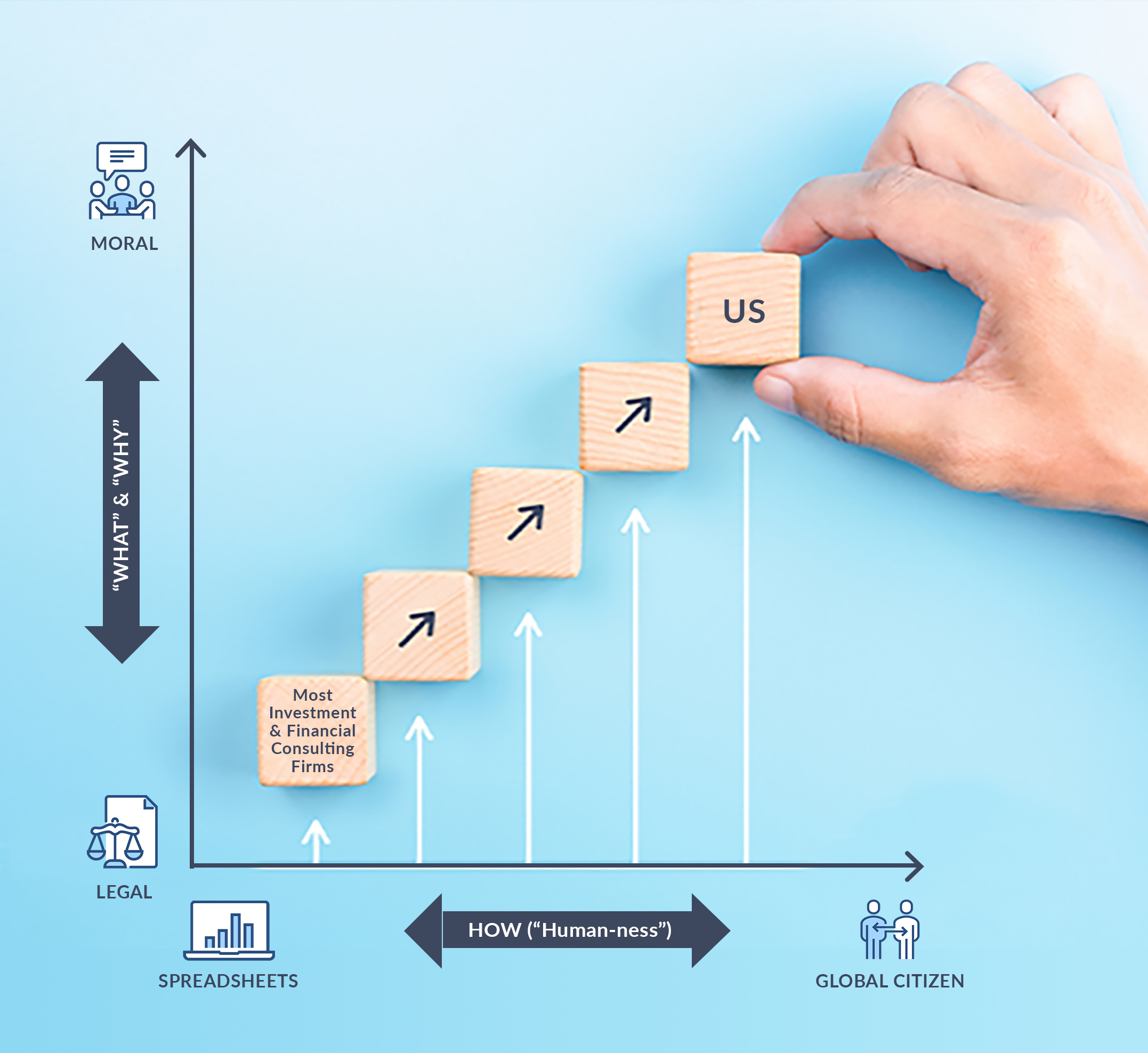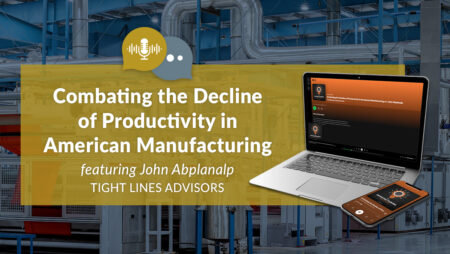
By John Abplanalp
As someone who has spent his life engaged in driving growth at every level of business operation, it’s always been evident to me that to be successful and meaningful to all stakeholders, a corporation needs positive purpose if it hopes to achieve sustainable profitability. This was evident in my first job as an assembly mechanic, during my years as a CEO and company President, and it continues today in my consulting work with companies for strategic planning, for operational improvement and true, sustainable, value creation.
Productivity is that existential element at the heart of empowering and sustaining an organization’s purpose (and productivity’s rate of improvement has been declining over the last 17 years in the U.S.). True purpose does not exist in a vacuum. It must be put to good use. It points people in the right direction so they can achieve results for the organization, for themselves and for others. Purpose serves as the unifying and motivational force.
One noteworthy quote about productivity comes from William E. Simon, former U.S. Secretary of the Treasury, who said, “Productivity and the growth of productivity must be the first two economic considerations at all times, not the last.”
Simon believed, and rightly so (though, it is seemingly now being ignored), that productivity is the foundational source of technology, innovation, jobs and wealth. A true statement when it was first made and STILL relevant to this day. But things have evolved, some would say drastically. Today, purpose and productivity now intersect in very complex and fluid ways since those words were first spoken. A company’s purpose needs to be clearly articulated and universally accepted among stakeholders to compliment the drive to productivity. Without it, the sustainability of an organization may ultimately be little more than a wish.
Productivity is the key driver of sustainability, but for the last several decades it has faced headwinds. The current U.S. Secretary of the Treasury, Janet Yellen, acknowledged her own uneasiness with the state of American productivity several years ago during her tenure as chair of the Federal Reserve. She noted that her greatest concern with the U.S. economy was the precipitous decline in the rate of productivity improvement that had occurred over the previous 15-20 years.
More recently, challenges to productivity have persisted through financial engineering and machinations. Then, in the last year, the ongoing health crisis and rapidly evolving societal norms emerged as significant additional impediments.
To maintain longevity in business, value must be created from the inside out. Productivity powers the value engine. And a clear, unified purpose provides the spark. Businesses that lack purpose experience low productivity and remain vulnerable due to negative mechanisms.
One such operational “roadblock” is redundancy. This may occur when disproportionate resources are devoted to a given purpose, or by repeating the same process or activity again and again, and expecting a greater outcome. Additionally, problems can develop by mistakenly thinking increased productivity is the by-product of getting the workforce to work harder, and therefore improve output; or by reducing the work force and theoretically cutting costs – i.e.: cutting workers but not eliminating the work.
In contrast, purpose-driven corporations achieve longevity through positive mechanisms by engaging, developing, and guiding their employees to remove the obstacles to productivity as opposed to removing employees to drive profitability. Sustainable productivity may be further realized by devoting the appropriate level of resources based on the prevailing conditions; utilizing information and feedback loops that allow a system to adjust to disruption in the business environment, and by learning and diversifying in response to shifts in the environment and society (“ESG”) that could impact its survival.
The old argument that manufacturing (in fact, most all) companies should SOLELY focus on their profitability is short-sighted and outdated (shareholder-centric). Driving sustainable productivity, and by association, the long-term existence of a corporation, may well rely on having a positive impact on its employees by placing as much energy and focus on them as in pursuing a healthy bottom line. Companies must develop ways to manage the proper balance and optimize a synthesis of societal, environmental, financial and employee well-being performance.
However, there are costs, financially speaking and otherwise, associated with achieving a proper balance. In some instances, the benefits may not be sufficient to outweigh the additional sum of those costs. The key is how to weigh it all vis-a-vis equal or greater profitability, because without sustainable profitability, no matter how good the intentions, the entity itself will not be sustainable.
This trend can be observed across the economic spectrum, from small businesses to global enterprises. American CEO members of the Business Roundtable recently indicated their understanding of the relationship between purpose and productivity. In 2019, a group of 181 U.S. corporate leaders changed their definition of the purpose of a corporation to creating value for “all of our stakeholders.” This phrase includes customers, employees and communities, rather than focusing exclusively on generating profits for shareholders.
Consider the following chart: (Full disclosure, it started out as a drawing on a napkin during a lunch meeting with Yves Montran. That’s not a cliché, it’s true.)

Rethinking purpose still involves the necessary foundational elements of income generation and wealth, but it incorporates new and profound aspects that generate significant impact on a company’s productivity. No longer is the adherence to legal and regulatory requirements sufficient to frame the “guardrails” of purpose. Today’s workforce is rapidly becoming a major factor in determining the purpose – and viability – of a company. Their direct input in establishing a purpose that’s reflective of their beliefs and values is as much, and sometimes more, a reason for working at a company as the financial compensation they receive. Some would argue that it has become a matter of morality over money.
Social and moral issues, as well as environmental concerns, are exerting great influence on determining the direction and purpose of a company as the chart suggests. More and more corporations are reporting that they are instituting programs which make them more attractive to work for because they support and serve a social good. This, in turn, can reduce turnover and save money. It’s also influential in workforce motivation and the productivity that results. People who constantly operate under conditions in an organization that, in their view, do not reflect their beliefs and values have been found to be less productive and have higher levels of disengagement and absenteeism.
Top-to-bottom stakeholder ownership of a company’s purpose is, in my view, a critical part of today’s formula for driving sustainable productivity. It goes beyond the “work harder because the company is aligned with my values” productivity, and extends to the “driving productivity while supporting, developing and guiding the work force” productivity.
Once established and implemented, productivity can also address other issues on which it depends. U.S. Treasury Secretary, Janet Yellin, summed it up rather succinctly when she stated, “Productivity depends on many factors, including our workforce’s knowledge and skills and the quantity and quality of the capital, technology, and infrastructure they have to work with.” Ultimately, the greatest indicator and necessity in achieving sustainable productivity, and therefore, profitability, growth and value creation in ANY organization, is enlightened leadership.
You’re probably juggling many of the issues I’ve outlined here. Some you navigate successfully, others may be a bit challenging. As someone who has spent the better part of four decades dealing with these same concerns, I continue to devote my efforts to helping companies in manufacturing and other business sectors drive greater productivity that aligns with their mission and purpose. Central to my mission is developing action-oriented programs that remove obstacles to productivity, improve gross and overall margins, along with enhancing competitive position, and thereby creating value for ALL stakeholders.
These companies look to Tight Lines Advisors and our proprietary (patent-pending) approach for expertise and experience in strategic planning, management, OEE, operational improvement, plant facilities layout/design and international business to assist them in overcoming their unique challenges. The approach is always on focus and motivation, so that every employee is involved as a stakeholder in driving the company forward. Through our process, organizational environments are created that empower enhanced performance at all levels and become the culture of the business entity. The result is operational excellence and value created from the inside out that’s reflected in gross margin improvement, greater competitive positioning and market sustainability.
One of the things that I enjoy most is the personal interaction with other business leaders and the ongoing exchange of insights and ideas. Whether it’s a personal conversation with a client, a university forum, or as part of a panel discussion, I view each interaction as an opportunity to share my knowledge, have a positive impact on manufacturing productivity and meet some great people.
If you’d like to talk purpose and productivity, I’m always interested in hearing what you have to say. I’d welcome the opportunity to walk you through our proprietary, patent-pending process, and how it can help increase your company’s productivity.
In my next article I’ll be sharing my knowledge and insights on how purpose-driven organizations can achieve sustainable productivity and increased profitability across a range of financial, economic and operational systems and programs.




